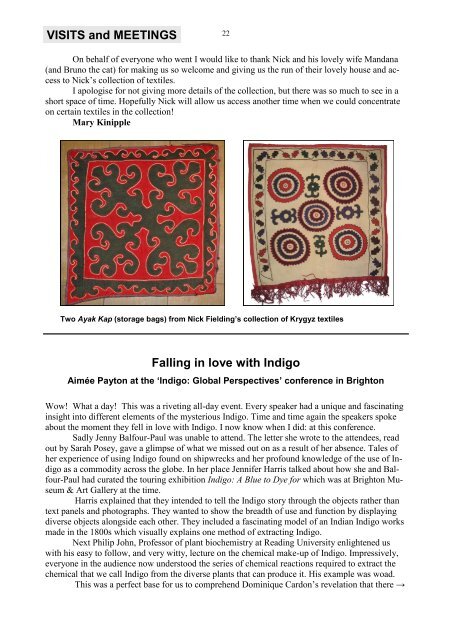Download - OATG. Oxford Asian Textile Group
Download - OATG. Oxford Asian Textile Group
Download - OATG. Oxford Asian Textile Group
You also want an ePaper? Increase the reach of your titles
YUMPU automatically turns print PDFs into web optimized ePapers that Google loves.
VISITS and MEETINGS<br />
22<br />
On behalf of everyone who went I would like to thank Nick and his lovely wife Mandana<br />
(and Bruno the cat) for making us so welcome and giving us the run of their lovely house and access<br />
to Nick‘s collection of textiles.<br />
I apologise for not giving more details of the collection, but there was so much to see in a<br />
short space of time. Hopefully Nick will allow us access another time when we could concentrate<br />
on certain textiles in the collection!<br />
Mary Kinipple<br />
Two Ayak Kap (storage bags) from Nick Fielding’s collection of Krygyz textiles<br />
Falling in love with Indigo<br />
Aimée Payton at the ‘Indigo: Global Perspectives’ conference in Brighton<br />
Wow! What a day! This was a riveting all-day event. Every speaker had a unique and fascinating<br />
insight into different elements of the mysterious Indigo. Time and time again the speakers spoke<br />
about the moment they fell in love with Indigo. I now know when I did: at this conference.<br />
Sadly Jenny Balfour-Paul was unable to attend. The letter she wrote to the attendees, read<br />
out by Sarah Posey, gave a glimpse of what we missed out on as a result of her absence. Tales of<br />
her experience of using Indigo found on shipwrecks and her profound knowledge of the use of Indigo<br />
as a commodity across the globe. In her place Jennifer Harris talked about how she and Balfour-Paul<br />
had curated the touring exhibition Indigo: A Blue to Dye for which was at Brighton Museum<br />
& Art Gallery at the time.<br />
Harris explained that they intended to tell the Indigo story through the objects rather than<br />
text panels and photographs. They wanted to show the breadth of use and function by displaying<br />
diverse objects alongside each other. They included a fascinating model of an Indian Indigo works<br />
made in the 1800s which visually explains one method of extracting Indigo.<br />
Next Philip John, Professor of plant biochemistry at Reading University enlightened us<br />
with his easy to follow, and very witty, lecture on the chemical make-up of Indigo. Impressively,<br />
everyone in the audience now understood the series of chemical reactions required to extract the<br />
chemical that we call Indigo from the diverse plants that can produce it. His example was woad.<br />
This was a perfect base for us to comprehend Dominique Cardon‘s revelation that there →

















